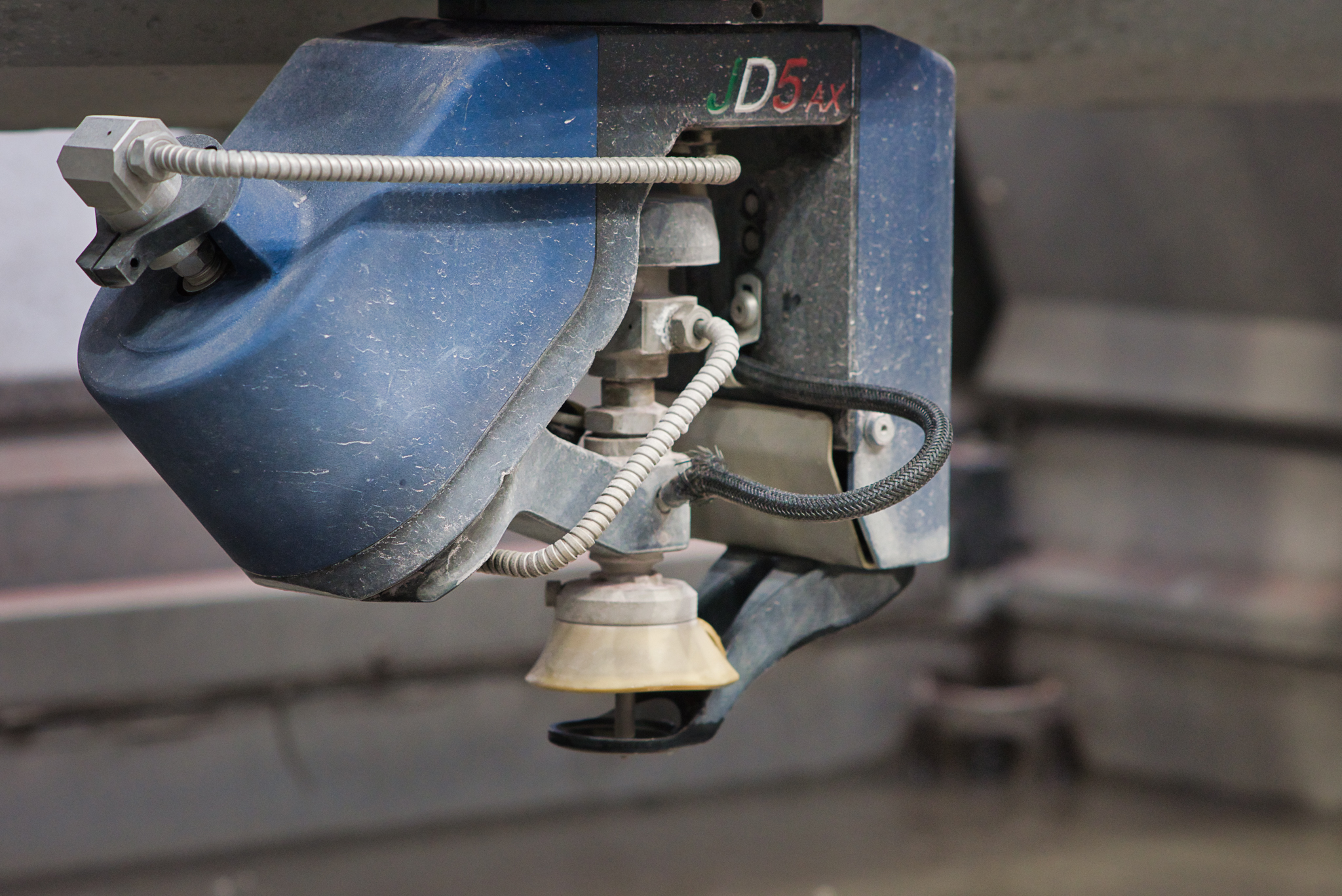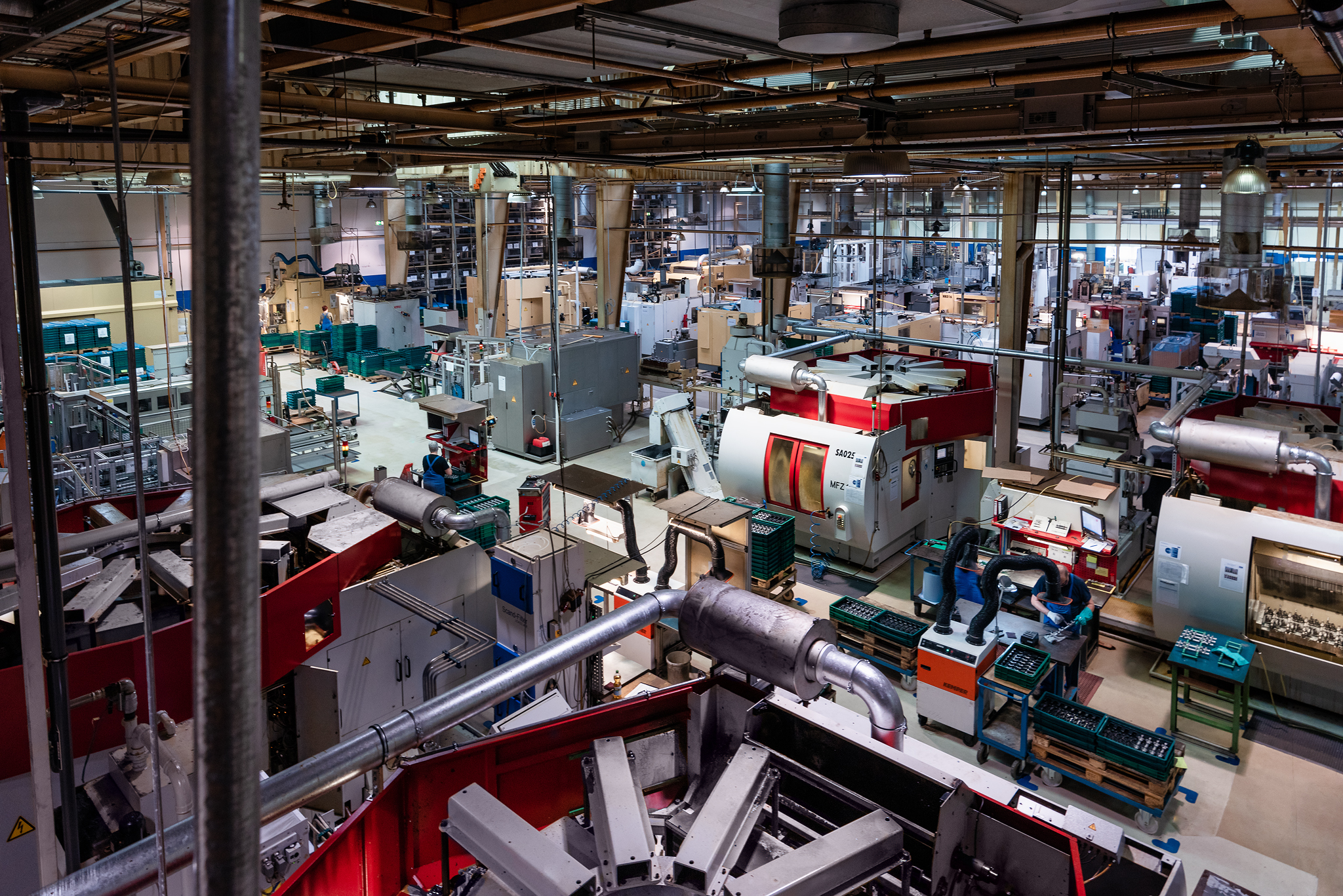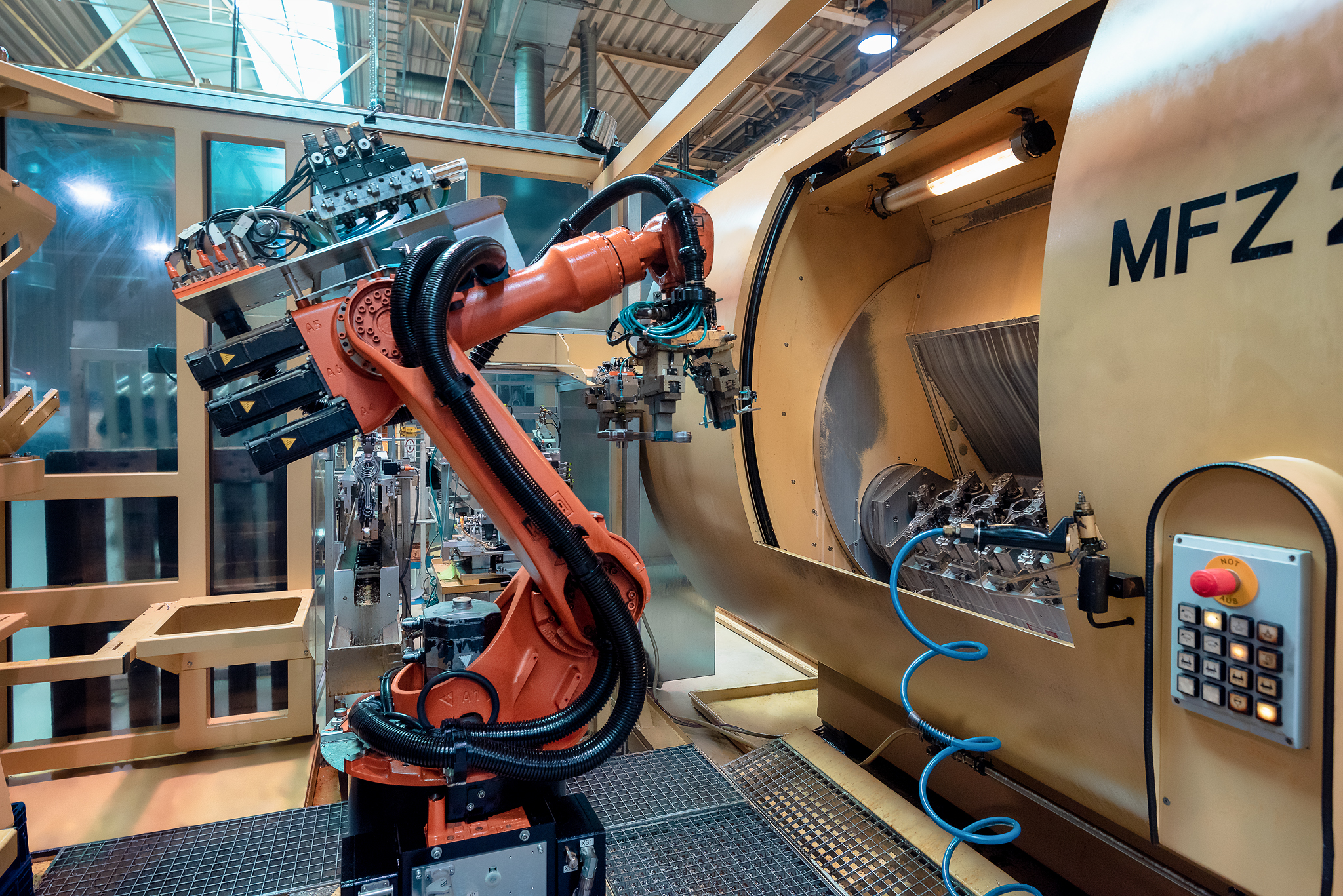How to photograph for a manufacturer?
Depending on the industrial field and the special market sector the typical plant sizes can vary. Inside very big factories it might be impossible to capture every single perspective in your camera. Therefore a thematically selection has to be made in mind, before the actual photo shoot is made. In Addition your customer or his marketing agency might have a wish list of interesting machines or perspectives in mind; ask them what they do expect from the photoshoot to be shown and what the photos are going to be used for.
Waterblasting machine for milling of Aluminium based parts
Nikon D810 | ISO 64 | Focal length 135mm (Nikkor 135 2.8 Ai-S) | f / 3.5 | Exposure time 1/40 sec
It depends on the individual photoshoot what has to be shown on the corporate photos …
Patrick, our Manufacturing Photographer, is showing what to look at, when capturing photographs of a corporate business photo shooting for a commercial business and some editorial use. The image composition is one key for stunning architectural photos at the top. Nevertheless, a content related message isn’t less important to convey meaning at a glance for a utile effect at an external representation of a company.
What to photograph when capturing an industrial plant
An American automotive supplier has three locations in Europe from where they deliver mainly the German Car Industry; but also companies like Peugeot, Fiat, Jaguar, Renault, Citroen and Seat are delivered with engine parts from that factory. The two plants in Germany and the main plant in Romania will be photographed by our industrial photographer Patrick Zasada. In the two German locations individual engine parts such as connecting rods or nozzles for the ABS-System are produced, while in the Romanian factory, the complete combustion engines for almost all German and European automakers are manufactured. The pictures are needed for the website, as well as for general PR purposes (business reports, brochures, flyers & show stands). The industrial photos should give an impression of the premises of the work. Particular attention is paid to the impressive size of the plant properties. At two locations, however, no aerial drone photographs should be made, as the plant roof is currently not in a good condition and should therefore not be shown. In addition, the exact location should not be apparent, as with a publication of the location an increased risk of industrial espionage is feared. This presents a particular challenge when it comes to the portrayal of the huge factory dimensions. Ultimately, a good impression of the manufacturing and work processes, as well as the size of the object should be conveyed with beautiful and stunning pictures, without giving too much detail about the actual processes.
Shooting the exteriors of the manufacturing plant at three business locations
The exterior photos of the factory plants should show the size of the local industrial company locations in the first place. The exact location or city should not be recognizable. Therefore it is not easy to create pleasant looking pictures with a clear content. At first we should use Google Maps to get a first impression and an overview of the industrial location.
Aerial drone photography of the industrial location
After some research of the location and an idea of where interesting perspectives might be expected, it is possible to start a drone for aerial photography. However, depending in which Country you are, there might be different regulations and rules regarding the usage of drones. Within Europe the states Luxemburg, the Netherlands and Belgium have very strict rules regarding drones. In most other European Countries the laws aren’t that strict like for example in most US American States.
This detailed aerial shoot gives an idea of the size of the object without giving away tom much information regarding the location. The lines also show an ascending character in regards to image composition.
DJI Phantom 4 Pro | ISO 100 | Focal length 24mm (equivalent) | Aperture 5.6 | Exposure time 1/400 sec.
If you shouldn’t show to much information about the actual location, you should concentrate on some details, like the truck docking stations, at least.
Exterior photography of very big commercial buildings
Most industrial plants or other commercial factory buildings are very long and huge in size, but not highly built. Very long but low halls are complicated to be photographed in a handsome way from a normal camera perspectives view. After capturing the main office entrance to the plant, it is necessary to go at least one time around the complete industrial plant construction an have a look for further interesting perspectives.
At the second location no aerial drone photographs should be taken. The very lengthy perspective lets you guess the size of the factory plant nonetheless. The Manufacturing Capabilities consist here of Crankcases, Cylinder Blocks, Balance Shafts, Chassis Components, Connecting Rods, Gear Housings, Common Rails and Pump Housings.
Nikon D810 | ISO 64 | Focal length 30mm (Tamron 15-30 SP) | f / 6.3 | Exposure time 1/640 sec
The main picture of the third location can not be shown in this article, because the company logo is too present at the plants entrance. But the backside also gives a good idea of the factory size. It is almost always a, from left to right, ascending character to observe in nice industrial photos with regards to image composition.
Nikon D810 | ISO 64 | Focal length 20mm (Tamron 15-30 SP) | f / 6.3 | Exposure time 1/800 sec
Photographing the Interior of an Industrial Plant and the Working Processes
When capturing photos of a manufacturing plant be aware of the safety regulations and do not disturb any working processes. In most cases you will have to shoot a lot of perspectives since every single corner might seem interesting for you. In Addition most industrial plants a very big and potentially you will have noch second chance to reshoot a special perspective due to a lack of time. Do not waste your time by using a tripod for every single photo; instead it is more practicable to us a wide zoom lens with very good image stabilisation (VR). Use a tripod only if you are sure that this is that photo which will be the best from all!
From a raised position, a good overview of the connecting rod production line can be captured within the plant interior. The image was aligned using the rule of thirds in regards to composition. The Manufacturing Capabilities consist at this location of Valve Bodies, Rails and Transmission Housings.
Nikon D810 | ISO 400 | Focal length 27mm (Tamron 15-30 SP) | f / 5 | Exposure time 1/20 sec
Detail shots complete every portfolio. This photo shows the steel connecting rods at quality control. Even with close-ups, the images are aligned and straight, the image section was regulated by the camera’s height.
Nikon D810 | ISO 500 | Focal length 35mm (Zeiss Distagon 35 2.0) | f / 4 | Exposure time 1/40 sec
The inclusion of the industrial robot required an intensive image retouching to remove the chips and make the image look clean. The rule of thirds was observed.
Nikon D810 | ISO 500 | Focal length 29mm (Tamron 15-30 SP) | f / 5 | Exposure time 1/30 sec
Even inside large interiors or factory parts, keep the camera straight to avoid falling lines. The line of sight is also ascending from left to right with regards to composition, when looking for the vanishing point.
Nikon D810 | ISO 320 | Focal length 23mm (Tamron 15-30 SP) | f / 5.6 | Exposure time 1/20 sec
Workplace: It was photographed from the back corner, the manufacturers workshop seems bigger from that perspective
Nikon D810 | ISO 320 | Focal length 15mm (Tamron 15-30 SP) | f / 5 | Exposure time 1/30 sec
Receiving warehouse at the main plant: Especially if rooms are not symmetrical (see ceiling), the central perspective is rather disadvantageous. A foreground is created by the location on the left in front of the boxes and the picture looks more dynamic.
Nikon D810 | ISO 80 | Focal length 24mm (Nikkor 24 3.5 PC-E) | f / 6.7 | Exposure time 1/10 sec
Next to the classical estate photos of the plants interior and some machines or detail shoots, it is recommendable to show some manufacturing processes with people. Just add a couple of staff photos from the factory workers during their working processes.
Intermediate check of an engine block by the factory worker. Just like detailed shots, photos of the work processes and some employees complete the business portfolio.
Nikon D810 | ISO 400 | Focal length 30mm (Tamron 15-30 SP) | f / 4 | Exposure time 1/50 sec
Taking pictures with employees is better if they look in the direction of the pictures center, instead of directing the view towards the edge of the frame. The open aperture provides a pleasant blurring and depth effect; The picture is divided into foreground, middle and background with the factory worker in the left third.
Nikon D810 | ISO 200 | Focal length 50mm (Zeiss Planar 50 1.4) | f / 1.8 | Exposure time 1/160 sec
“The photographed company is an international leading and diversified manufacturer of metal system components with operations in the USA and Europe. Manufacturing of highly engineered products, including formed, machined and cast metals for engine parts and serving major original equipment for manufacturers of automotive, industrial and transportation products is what they stand for.”















